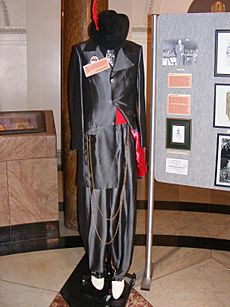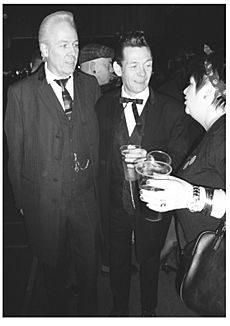Zoot suit facts for kids
A zoot suit is a special kind of men's suit. It has high-waisted, wide-legged pants that get tight at the ankles. The jacket is long with wide lapels and big, padded shoulders. This unique style became popular in the 1940s among African American, Mexican American, Filipino American, Italian American, Jewish American, and Japanese American communities.
The zoot suit first appeared in an African American comedy show in the 1930s. Jazz singers helped make it famous. Cab Calloway, a famous jazz bandleader, even called them "totally and truly American." A young Malcolm X also wore them. During World War II, there were shortages and rationing of materials like wool. Because zoot suits used a lot of fabric, some people criticized them as wasteful. After some violence against people wearing zoot suits, the suits were actually banned in 1942 for the rest of the war.
History of Zoot Suits

The zoot suit was first created by Ernest "Skillet" Mayhand. He wore them as part of his comedy act called "Pots, Pans & Skillet." The suits first became known in African-American communities like Harlem, Chicago, and Detroit in the 1930s. But jazz musicians made them popular all over the country in the 1940s. The word "zoot" might have come from repeating the word "suit" in a fun way.
Jazz bandleader Cab Calloway often wore zoot suits on stage. Some of his suits had very wide shoulders or extra long jackets. He even wore one in the 1943 movie Stormy Weather. In his own dictionary, he described the zoot suit as "the ultimate in clothes. The only totally and truly American civilian suit."
A song called "A Zoot Suit (For My Sunday Gal)" was written in 1942.
In 1943, there were conflicts in Los Angeles known as the Zoot Suit Riots. These involved Mexican-American youth. Some people saw the zoot suits as unpatriotic because they used so much fabric during wartime. Because of this, zoot suits were later banned for the rest of World War II. This was mainly because of how much cloth they used.
The Tom & Jerry cartoon The Zoot Cat (1944) made fun of the zoot suit trend. In it, Tom tries to impress a girl by wearing a zoot suit.
Pachuco was a style of Mexican-American culture and dress. Both men and women (Pachuca) wore zoot suits as part of this style. Wearing zoot suits was a way for Pachucos and Pachucas to challenge ideas about ethnicity and gender.
Tin-Tan, a famous Mexican actor from the 1940s, wore zoot suits in his movies. The labor leader César Chávez also wore zoot suit clothing when he was younger.
The 38th Street gang in Los Angeles was known for wearing zoot suits in the 1940s.
Zoot suits were also important in other places, like Trinidad. Trinidadian men who wore these suits were called "saga boys." They loved the fancy lifestyle that came with the suits. By wearing zoot suits, they were showing that they didn't agree with British ideas about fashion and manhood. They used this style to improve their lives and create their own culture.
In a 1951 Three Stooges short film, Shemp finds a magic lamp. He wishes for a new suit and gets a brand new zoot suit.
Some people think that the "Edwardian-look" suits worn by Teddy Boys in Britain came from the zoot suit style.
What Zoot Suits Looked Like
Zoot suits were usually worn with a fedora or pork pie hat. These hats often matched the suit and sometimes had a long feather. People also wore pointy, French-style shoes.
A young Malcolm X once described the zoot suit as: "a killer-diller coat with a drape shape, reet pleats, and shoulders padded like a lunatic's cell." Zoot suits often had a long watch chain. It would hang from the belt down to the knee or lower, then back up to a side pocket. Women who were with men wearing zoot suits often wore a flared skirt and a long coat.
Zoot suits used a lot of fabric and needed special tailoring. This made them expensive. The U.S. War Production Board said that they wasted materials needed for the World War II war effort. When Life magazine showed pictures of zoot suit wearers in 1942, they joked that the suits were a good reason to lower the Army draft age. This expensive style was seen as unpatriotic during wartime. This was a reason for the Zoot Suit Riots. For some people, wearing the big suit was a way to show freedom and independence.
Images for kids
-
A soldier with two men wearing zoot suits in Washington, D.C., 1942
See also
 In Spanish: Zoot suit para niños
In Spanish: Zoot suit para niños





